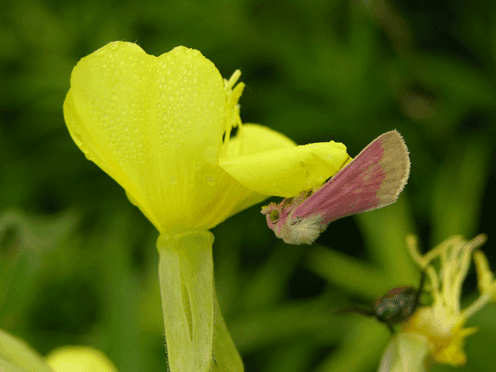New research finds rapid evolution in plants to resist predatory insects
Schinia florida rests on an evening primrose flower the Cornell University researchers were working with. (Photo courtesy of Anurag Agrawal.)
From the spiciness of the chili pepper to horseradish’s bitter bite, many plant traits are evolutionary adaptations to insect attacks.
For millennia, insects, such as the silkworm and its mulberry trees, have in turn helped guide the evolution and defenses of plants.
A five-year study from researchers at Cornell University, including biologist Anurag Agrawal, recently published in Science Magazine, focuses on the critical role insects can play in plant evolution, and how speedy that evolution can be.
“Essentially plants are the only group of organisms on the planet that can generate their own energy,” Agrawal said. “Something that we don’t often think about is the entire biosphere — all organisms in the food chain — are either directly or indirectly dependent upon plants.”
And while lions and tigers might not eat plants, or even a specific animal that eats plants, the food chanin all leads back to that only living organism that produces its own energy. So, Agrawal says, plants have had to develop a complex system of defenses, to deter the creatures that get their energy from eating plants.
Often, those creatures are insects, specifically herbivore insects.
“What makes horseradish spicy? Horseradish is spicy because of a series of compounds called glucosinolates that we believe have evolved by natural selection to ward off insects,” he explained. “The poisons that make milkweed so famous? You know, same expectation.”
Nicotine is a neurotoxin that evolved in tobacco, in order to ward off insects.
Through research, Agrawal discovered that in as little as five years, plants can change their behavior if they no longer have to worry about insect attackers. Specifically, within five years, Evening primrose treated with insecticide started to flower later and produce fewer of the toxins that defend it from insects.
“The results that we got we had anticipated, and it was sort of part of our hypothesis, but what really surprised us was the rapidity of this evolutionary response,” Agrawal said. “Seeing this response in five years was dramatic.”
Typically, evolution is imagined over the course of hundreds or thousands or even tens of thousands of years.
“In our study, what we’re talking about is the rapid adaption that occurs within a species, and the way one might think about how this might be operative in nature is as the climate changes … we can expect to see rapid change in those populations,” Agrawal said.
Agrawal says one of the important takeaways here is merely that evolution is taking place — and happening all around us.
“The fact that we can in real time, see that change in genes and genotype frequencies in that short period of time is a critical message to the public,” he said.
The long-term implications from the study are as yet unclear. But certainly, Agrawal said, when we use insecticides to take insects out of the picture for plants, the plants relax their defenses — which could have long-term implications.
“I think is unfortunately really a big part of worldwide agriculture, and that is that we tend to select varieties of plants to grow that are diminished in their natural defensive capacities,” he said. “If you take a wild plant that has survived out there for millions of years, it typically has a remarkable array of toxins and defense tactics to ward off pests.”
In other words, we breed crops so that they have relaxed defenses, which increases our need for and use of pesticides, which I think we can all agree is problematic for the environment.
